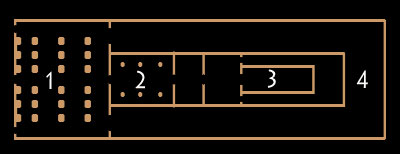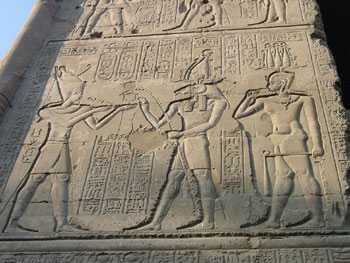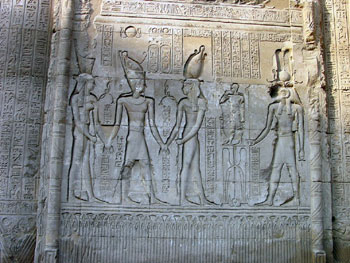The town of Esna (Iunyt or Ta-senet to the ancient Egyptians and Latopolis to the Greeks) is roughly 50 km south of Luxor (ancient Thebes). It seems that the first temple (or shrine) in Esna was built during the reign of Thuthmosis III (during the New Kingdom), but the present temple dates from the Greco-Roman period, when the town of Esna became the capital of the third nome of Upper Egypt.

The temple of Esna is primarily dedicated to Khnum (a god of the Nile who moulded the “ka” on his potters wheel) but was also dedicated to a number of other deities, most notably Neith (the ancient goddess of war and weaving), Heka ( the personification of magic), Satet (a goddess of the Nile), and Menhet (the lion goddess who was the wife of Khnum at Esna).

- Hypostyle hall (excavated)
- Hypostyle chamber
- Sanctuary
- Gallery
The temple was built almost nine metres below ground level. Although the hypostyle hall was excavated by Marriett, the rest of the temple is still buried underneath the modern town. As a result, the temple appears to sit in a large pit hollowed out from the town. Although some masonry blocks attesting to the construction during the reign of Thuthmosis III have been reused at the site, the oldest complete part of the temple is the back wall of the hypostyle hall which was built during the Ptolemaic period and features depictions of Ptolemy VI Philometer and Ptolemy VIII Euergetes. The rest of the excavated building was built by a series of Roman Emperors from Claudius (41-54 AD) Decius to Decius (249-251 AD).


The roof of the hypostyle hall is supported by twenty four columns with beautifully carved and painted floral capitals in a variety of designs (see below). The columns are decorated with texts describing the religious festival and depict several Roman emperors before the ancient Egyptian gods. For example, one depicts the Emperor Trajan dancing before the goddess Menhet.

On the northern wall of the hall the pharaoh is depicted catching wild birds – symbolically representing him subduing evil spirits. At the east corner there is a strange hymn to Khnum in which the name of the god is written using the hieroglyph of a crocodile. At the opposite corner the hymn is repeated but with the name of the god written with the more traditional ram head. The decorations also include a number of calendars and the ceiling is decorated with Egyptian astronomical figures on the northern side and Roman zodiacal signs on the southern side.
Bibliography
- Bard, Kathryn (2008) An introduction to the Archaeology of Ancient Egypt
- Baines, John and Malek, Jaromir (1980) Atlas of Ancient Egypt
- Robins, Gay (1997) Art of Ancient Egypt
- Wilkinson, Richard H. (2000) The Complete Temples of Ancient Egypt
Copyright J Hill 2010